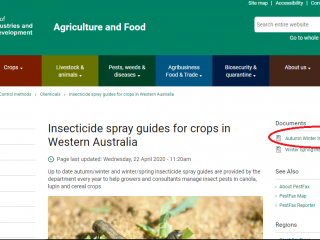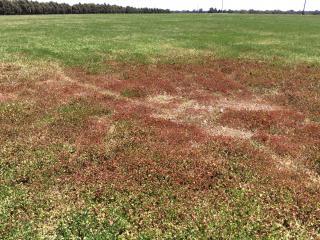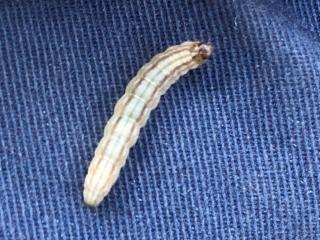Tips for checking germinating crops for caterpillars and other insect pests
- Kellerberrin
- Badgingarra
Brad Joyce (ConsultAg) reports that weed web moth caterpillars were found causing some leaf damage to 2-4 leaf canola north of Kellerberrin, which was sown in late March. He noted the webbing could be found amongst damaged plants.
An Agworld user has also report finding weed web moth caterpillars near Badgingarra.
Weed web moth caterpillars reach 15 mm in length and are slender, hairy, and can vary in colour between grey-green, dark-green or pale-brown. They have a black head and older larvae have a dark stripe down the middle of their back with three rows of small dark spots. For more information refer to cesar’s Weed web moth page.
Previous caterpillar activity reported this season can be read about in the 2020 Pre-season PestFax newsletter article Early caterpillar activity is a concern for future emerging crops.
Checking emerging crops for insects
As crops emerge, it is important to remember that differences in pest biology, as well as seasonal differences, mean that no one tactic or approach will effectively control pest issues in all situations.
Therefore, frequently checking crops during the first 3-5 weeks is a key to early detection of pest issues and intervention as necessary to ensure crops get away to a healthy start.
When checking crops sometimes pest damage is visibly obvious but finding and identifying what insect pest, or combination of pests, is causing the damage may not always be so simple.
The following tips might be useful to identify damaging insect pests in emerging crops;
- Look up and down the seeding rows for missing plants that may have been chewed off at the base or plants with visible chewing damage.
- Look for insects around and under chewed or missing plants. Don't forget to check under the stubble in the inter-rows.
- What type of damage has the plant sustained? Understanding the preferred feeding methods and mouth parts of insects can help narrow the lists of culprit insects. For example chewing damage above or below ground is the feeding method favored by caterpillars (such as webworm or cutworm), European earwigs, weevils and other beetles. Sucking-type damage appears as wilting and yellowing of plants and is favored by aphids and Rutherglen bugs who have piercing and sucking mouthparts.
- Still can't find a pest? Place a pitfall trap near the damage, this is just a plastic cup dug into the ground so the top is flush with the soil surface. Put about 10mL of water into it and come back after 24 hours. This has been especially useful in detecting the presence of weevils, slaters and European earwigs. European earwigs are one of the few pests that if numbers are high, can damage well established crops especially if they chew through the stem.
- Have you found an insect in the paddock that you have not seen before? It could be an incidental or it could be a new pest species. Consider taking the time to get it identified. It is hard to identify an insect from a verbal description. But there are a few things you can do. Have a phone or tablet that takes photos? Take a photo and email it to DPIRD entomologists Dusty Severtson or Svetlana Micic. We also encourage taking a photo and attaching it to your report when using the PestFax Reporter app.
DPIRD entomologist Svetlana Micic goes into more detail about monitoring crops for insect damage and identifying them in the department’s How to monitor for early season pests YouTube video.
If you do find insects in the paddock make sure they are correctly identified as not all insects that are caught may be crop pests.
The PestFax team wants to know what invertebrate insects you are finding in your crops and pastures, whether it is a pest, beneficial or unknown. We even want reports of the usual insects that are seen every season. Please send your reports in via the PestFax Reporter app.
For more information on monitoring insects in emerging crops refer to;
- DPIRD’s Monitoring insects and other crop pests page
- GRDC’s Monitoring for insects in canola. Part 1 video
- GRDC’s updated I SPY manual.
For more information on webinar topics contact research scientists Dustin Severtson, Northam on +61 (0)427 196 656 or Svetlana Micic, Albany on +61 (0)427 772 051.
Article authors: Cindy Webster (DPIRD Narrogin) and Dustin Severtson (DPIRD Northam).
2020 autumn winter insecticide spray guide is now available

The 2020 autumn/winter insecticide guide is now available and can be downloaded for free at the department’s Insecticide spray guides for crops in Western Australia page.
This spray guide lists the latest registered chemicals and rates that can be applied to canola, lupin and cereal crops for controlling seedling insect pests.
The department updates its autumn/winter and winter/spring insecticide spray guides annually to help growers and consultants manage insect pests in crops and pasture.
The spray guides are only a guide and growers still need to read chemical labels before use.
Not all insecticide trade names may be listed so growers should also check with their retailers for any other registered insecticide options.
To download these spray guides and other useful insecticide information visit the department’s Insecticide spray guides for crops in Western Australia page.
For more insecticide information contact Dustin Severtson, Research Scientist, Northam on +61 (0)427 196 656.
Article author: Cindy Webster (DPIRD Narrogin).
Increased likelihood of sub clover red leaf syndrome in pastures

Recent rainfall and warm conditions in some parts of the south west of WA may lead to aphids spreading the Soybean dwarf virus (SbDV) and causing an outbreak of sub clover red leaf syndrome.
Symptoms of SbDV include; red leaves, stunted plants and even premature plant death.
Farmers who suspect red leaf syndrome in their subterranean clover can access free testing by the Department of Primary Industries and Regional Development (DPIRD) Diagnostic Laboratory.
DPIRD and the University of Western Australia (UWA) are keen to test plants with symptoms as part of broader work to better understand this syndrome which can severely stunt pasture growth. This work is being done in collaboration with GRDC project (DAN00202) which is examining virus threats to the grain pulse industry. DPIRD officer’s Paul Sanford and Ben Congdon along with UWA researcher Kevin Foster are co-leading the work.
SbDV is not a seed borne virus but is spread by aphids if growers can control the aphids there is a good chance they can manage the syndrome.
Autumn control options to consider include spraying for aphids using an anti-feeding insecticide at two and six weeks after sub clover seedlings emerge. This group of insecticides prevent aphids feeding.
Oats can also be sown as a barrier around pasture paddocks to disperse aphids and slow early spread into pasture from outside sources.
The syndrome has occurred in the central and southern agricultural areas of WA for many years, however surveillance was initiated in 2017 after severe losses occurred for the first time in some areas including Dalwallinu, New Norcia, York, Brookton and Katanning. The syndrome has been present on the south coast for many decades.
How do growers test for SbDV?
To arrange free testing growers are urged to first contact research officers Paul Sanford (DPIRD) or Kevin Foster (UWA).
Samples will then need to be mailed to DPIRD Diagnostic Laboratory Services, Specimen Reception C Block, DPIRD, 3 Baron-Hay Court, South Perth WA 6151.
Growers who submit samples are provided with the test results and management advice.
Affected growers are invited to participate in online survey
Meat and Livestock Australia and Australian Wool Innovation are hosting an online Producer Survey which enables producers to report incidents and enable the livestock funding bodies to determine the extent of the problem, which will in part define future support to tackle the issue. To contribute to the survey go to the MLA website.
For more information on identifying and managing the sub clover red leaf syndrome refer to DPIRD’s Subterranean clover red leaf syndrome as caused by soybean dwarf virus page.
For more information contact Paul Sanford, Senior Research Officer, Albany on +61 (0)8 9892 8475 or or Kevin Foster, UWA Pasture Researcher, Nedlands on +61 (0)8 6488 2220.
Article authors: Paul Sanford (DPIRD Albany) and Cindy Webster (DPIRD Narrogin).
PestFax webinar recording is now live
On Wednesday the 15 April the PestFax team delivered a webinar about pre-season invertebrate topics that were tailored for growers and consultants in the western region.
Entomologist Dusty Severtson (DPIRD) presented the topics;
- Insect lessons learnt from 2019
- Green bridge pests to watch out for at crop emergence
- Fall armyworm.
Entomologist Svetlana Micic (DPIRD) presented about;
- What non-green bridge pests to look out for
- Redlegged earth mite resistance update
- Baiting for European earwigs, slaters and millipedes
- Slugs and snails: when to bait and why.
PestFax newsletter Cindy Webster (DPIRD) then discussed what services the PestFax team provides to growers and consultants and what DPIRD apps are available to assist with insect identification and management.
It was a great turn out with 70 attendees dialling in. There were plenty of questions and discussion at the end of the webinar. Fall armyworm questions were very popular.
To view the recording of this webinar click here.
For more information on webinar topics presented contact research scientists Dustin Severtson, Northam on +61 (0)427 196 656 or Svetlana Micic, Albany on +61 (0)427 772 051 or Cindy Webster, Narrogin on +61 (0)404 819 534.
Article author: Cindy Webster (DPIRD Narrogin).

